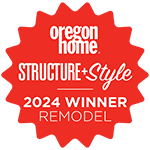Technology is becoming more and more sophisticated by the day. If you're planning on remodeling your home (or attic), be sure to check out the technology that can help you save money on energy, improve the security of your home, and make everyday tasks easier. We've rounded up 12 of the technology trends we've seen in newly renovated homes around Portland.
1. Digital Home Hubs
Voice-activated “digital home assistants,” such as Amazon’s Alexa and Google Home, which reside in a wireless speaker and can look up information for you on the internet, make hands-free phone calls, and control your home’s smart devices such as TVs, sound systems, lights, locks, and thermostats.
Worried that all this connectivity is going to put your home at risk for hackers or trolls with too much time on their hands? Engineers are working on solutions to that, too. You can choose hubs that keep their information in the Cloud for easy portability or stick with something closer to home. Some options, like Habitat, keep their data locally. That makes them harder to access.
2. Smart Refrigerators
If you’re like a lot of people, the refrigerator is the hub of information in the kitchen. A refrigerator with a touchscreen on the door allows you to do what most tablets do: Display calendars and photos, write notes, stream music, watch TV. And inside, the fridge has cameras that take pictures every time the door is closed. When you’re at the store and wonder if you need milk, you can just pull up the photos on your phone and see for yourself. If your kids are always digging into the fridge and leaving the door open, you can monitor the temperature and request rapid cooling to keep everything safe and ready to eat.
If you’re willing to invest a little more, you can turn your smart fridge into its own little hub for the kitchen. Use the screen to create settings for other devices. You can even set it up to provide instant hot water on demand, or produce your favorite cup of coffee right on schedule.
3. Smart Locks
Smart locks that you can control remotely make getting in and out of your home a snap, even for the kids or guests. This is one of the oldest smart technologies, but that just means that it’s been tested and proven to work great. If you need to let in a worker or a visitor when you’re not home, you can give that person a one-time entry code. Smart locks also allow you to lock and unlock the door from your phone, check to make sure the door is locked, and keep track of who has come and gone.
4. Smart Windows and Doors
If you (or more likely, the kids) are constantly forgetting to close the garage door or the windows, you’ll love this remote operation technology. Garage door controllers, which work with existing garage door openers, allowing you to control the door remotely. You also can receive alerts when the garage door is opened or closed.
Smart windows take convenience to the next level. Need the windows or the blinds closed? You can run it from an app. You can even set it to move based on a specific amount of light, based on sensors. You’ll enjoy better efficiency as well as comfort.
5. Smart Thermostats
Smart thermostats, the most popular smart device added in a remodel, learn your preferences after several days and automatically adjust your home’s temperature the way it has “seen” you do it. Other models can sense if someone is home and adjust the climate accordingly.
These have been on the market for a while, which means that they’ve come a long way. If you worried about manufacturers working out the kinks in the first few generations, you can rest easy now. The latest models feature excellent voice control and updated privacy protections.
6. Wi-Fi Cameras
A doorbell camera lets you see who’s at the door, no matter where you are. An app can send you a message whenever someone rings the bell, and it allows you to turn the camera on and off, adjust the doorbell chime, lock and unlock the door, and speak to visitors through the doorbell.
Other web-connected cameras keep track of what’s going on inside your home. Footage or screenshots from the cameras can help the police identify intruders. These cameras can even notify you of activity in your home, and you can speak through the camera and scare off an intruder.
7. Smart Home Security
Locks, cameras and lighting fall under the category of home security, but it’s nice to have an integrated system that makes them all work together. With smart home security, you can arrange for monitoring from a company, as well as alerts when someone comes to your door or tries to open it. There are enough options now that you can get exactly what you’re looking for, whether it is completely DIY, mostly managed by a professional team, or somewhere in-between.
8. Smart Light Bulbs
When you forget to turn out the lights before you go to bed, you really can turn them off from your smartphone. LED light bulbs let you control them remotely, dimming and changing the color of the bulbs as the mood strikes. If you find that the current lighting is too bright or has a color temperature that makes it hard to focus or settle down for the evening, you’re not alone.
There’s a wide range of options and many bulbs give you dozens of choices that you can tailor from an app. Other smart bulbs are built for home security, mimicking your lighting habits to make it look like you’re home, turning on when the doorbell or burglar alarm rings, and staying on even if the power goes out.
9. Smart Plugs
If you tend to arrive a little late to the technology game, you’re probably wondering if getting a smart home means you have to buy all new appliances and furnishings. For most things, the answer is no. Just get a smart plug. If you have a hub that you can connect for a variety of devices, there’s probably a smart plug that works with it. Instead of having to buy smart lighting, you can plug in your existing equipment to a smart plug. This makes it easy to control the operation and keep an eye on your energy usage.
10. Smart Mirrors
In our multi-tasking world, even getting ready in the morning often requires a little extra work. It’s a boon to have a bathroom mirror that’s also a TV that’s also a tablet that can fetch information, compose emails, play music, and more — with voice commands or a touch of the glass.
And while that’s more than enough in a smart mirror, you can definitely get more. The latest models give you options to adjust the lighting, which is important for people who need to get their look just right. You can even get recommendations on your skincare regimen.
11. Smart Toilets
If you’ve never heard of a smart toilet, that’s no surprise. This technology is taking the rest of the world by storm, but people in the U.S. are still getting used to the idea. In truth, it’s amazing. You’re probably already familiar with self-flushing toilets that tend to flush a little unpredictably. Now, imagine that you can control the flushing function. Not sure if you took care of it in the middle of the night? Just flush it from your phone.
Now, think about how everything you dislike about toilets could be solved by the right technology. If you hate sitting on a cold seat, you can have it heated to the perfect temperature. If you’re interested in a bidet but terrified of a freezing jet of water, you can get that heated, too.
12. Smart Sprinkler Systems
There’s nothing like planning for a small get-together or just some quiet time in the backyard, only to get rained out – literally. Sprinkler systems have come a long way in just the past 10 years. Smart controllers can use your existing system in a whole new way. Instead of having to operate your controller or reset the watering schedule from a station located on your property, you can do it from a smartphone. These are pretty easy to set up and can also give you data about water usage, depending on the product.
Don’t have a sprinkler system underground? No problem. There are devices that connect to your hose, too. You’ll need a hub to control it, but this can be a simple alternative to digging up your landscaping. Just plug it into your tap and use the hub to set the time. Then you can make sure your garden gets just the right amount of water at an appropriate time of day – and no worry about forgetting to turn it off.
All this amazing technology comes with a couple of caveats. With this much connectivity required throughout the house, a run-of-the-mill Wi-Fi setup probably won’t be enough. Wi-Fi mesh networking involves additional wireless modules installed in areas of the home where the Wi-Fi signal is weak. Also, keep in mind that several types of connectivity exist, such as Wi-Fi, ZigBee, Z-wave, and Bluetooth. Your smart devices need to be speaking the same language to work together.
The good news is that some systems are designed to convert machines running on one type of system to work with another. But that tends to make the process more complex and easier to get confused. If you’d rather enjoy using the devices more than setting them up, it’s easy to hire someone to take care of the connections for you.









